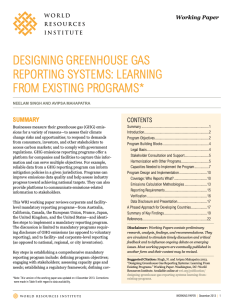Designing Greenhouse Gas Reporting Systems: Learning from Existing Programs

Synopsis
Mandatory reporting programs help build a strong foundation to manage greenhouse gas (GHG) emissions and strengthen countries’ capacity to adequately tackle climate change. This working paper provides insight into the factors influencing the design and development of reporting programs and capacities needed for their effective implementation. It identifies decision drivers and steps in developing mandatory GHG reporting programs.
Note: This version of the working paper was updated on December 5, 2013 Corrections were made in Table 9 with regard to data availability.
Key Findings
Although program design must be context specific, some common elements can guide jurisdictions planning mandatory reporting programs:
-
A reporting program can fulfill a number of short-term and long-term objectives, which may be periodically reviewed to ensure they remain relevant and realistic with the country’s evolving policy landscape. Objectives influence the program design and implementation related decisions.
-
Building blocks that support program design and operation details include a sound legal basis; effective stakeholder engagement; and adequate institutional, human, technical, and financial capacity.
-
Harmonizing with existing programs and learning from them can allay concerns about duplication and strengthen the reporting program.
-
Issues related to program design—coverage, monitoring and calculation methodologies, reporting requirements, verification, and data disclosure and presentation—are influenced by program objectives, stakeholder interests, and the level of preparedness and capacity in the country.
-
Jurisdictions may make different choices at each step. The decision drivers underpinning these choices provide an insight into the kind of analysis policymakers can undertake to arrive at appropriate and justifiable decisions for their reporting programs.
-
Developing countries with competing priorities and limited resources may find it easier to adopt a gradual, phased approach to develop a reporting program. Immediate investments in capacity building and stakeholder engagement can assist in strengthening implementation later.
Executive Summary
Businesses measure their greenhouse gas (GHG) emissions for a variety of reasons—to assess their climate change risks and opportunities; to respond to demands from consumers, investors, and other stakeholders to access carbon markets; and to comply with government regulations. GHG emissions reporting programs offer a platform for companies and facilities to capture this information and can serve multiple objectives. For example, reliable data from a GHG reporting program can inform mitigation policies in a given jurisdiction. Programs can improve emissions data quality and help assess industry progress toward achieving national targets. They can also provide platforms to communicate emissions-related information to stakeholders.
This WRI working paper reviews corporate and facility-level mandatory reporting programs—from Australia, California, Canada, the European Union, France, Japan, the United Kingdom, and the United States—and identifies steps to implement a mandatory reporting program. The discussion is limited to mandatory programs requiring disclosure of GHG emissions (as opposed to voluntary reporting), and to facility- and corporate-level reporting (as opposed to national, regional, or city inventories).
